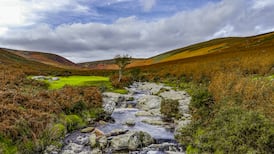I was crouched over my telescope counting a large flock of mixed waders and gulls in Dublin Bay when suddenly, without warning, every bird took off. Curlews, godwits and knots flew out to sea, dunlins and redshanks scattered further along the beach while a small family group of brent geese headed inland, to seek refuge on a football pitch. The source of the disturbance, two dogs off the lead, splashed out into the water to disperse the last of the swimming gulls. Their owner seemed to be oblivious to the chaos they had caused.
Migratory waterbirds live on a knife-edge of survival. Flying south after the breeding season to escape the Arctic winter, they must feed intensively to restore their fat reserves, maintain energy throughout the cold winter months and then build up fat again for the long return migration. On arrival and during harsh weather spells they may be exhausted and close to starvation. Their main aim then is to get enough food each day and to conserve enough energy during times that they can’t feed.
Estuaries and other coastal wetlands provide an abundance of food for dozens of species of waterbirds. Geese graze on seagrasses and seaweeds. Curlews, godwits, oystercatchers and other waders target a range of marine worms and shellfish while gulls will scavenge on anything they can find. Their feeding times are controlled by the tide rather than daylight hours, with many species foraging through the night when the tide is low. At high tide they usually roost together in tight flocks at the top of the shore, on salt marsh or sand-dune spits, and on offshore islands where they are relatively safe from ground predators.
Of course, aerial predators such as peregrines or sparrowhawks take a small number of shorebirds each year and the appearance of one of these raptors on a shoreline will definitely disturb their potential prey. The flocking strategies of waders, in particular, have evolved to give them the greatest chance of surviving. However, human disturbance on coasts adds another hazard which the birds have to deal with. This is especially the case on sandy beaches close to our main towns and cities where recreational use can be intense at all times of day.
READ MORE
The main causes of disturbance to shorebirds are people and their dogs. Other sources, that the birds may view as threats, include kitesurfing and driving cars on beaches. The use of drones in coastal areas may be a similar threat as birds often regard these in the same way as they do birds of prey. Even birdwatchers and photographers can be at fault sometimes. In pursuing our own hobbies, we need to be aware that we can cause unnecessary impacts by approaching wildlife too closely in natural habitats.
[ For wintering waterbirds it’s ‘death by a thousand cuts’Opens in new window ]
Some shorebirds need to add up to 50 per cent of their total body weight in fat reserves to act as fuel for their long migrations to the Arctic breeding grounds in spring. If they fail to find enough suitable food or are forced to use up their energy in avoiding disturbance, this may tip the balance against survival or leave them in a weakened condition that will prevent them breeding. If disturbance reduces their intake of food items below a critical threshold, birds must move or starve. If they have to shift to alternative feeding areas, these may already be occupied by birds of the same species, thus increasing competition between individuals, with inevitable reductions in prey intake.
As a dog-lover myself, I know that the natural instinct of canines is to chase potential prey. But training and use of a lead by the owner will ensure that, in sensitive areas, dogs can be controlled and disturbance avoided. Notices posted in appropriately sited locations and wardening at busy times of day can help to inform owners that dogs should be on a lead near to flocks of birds.
[ Dog dirt the biggest contributor to poor quality Dublin bathing waterOpens in new window ]
It is clearly not feasible to ban people or dogs completely from all beaches containing birds but there is a strong case for some key foraging and roosting areas to be designated as “No Dog Zones”. Local authorities already use bylaws to restrict activities such as the use of jet-skis and other powered craft in the vicinity of swimming places so similar restrictions could be introduced to protect key locations for waterbirds. These have the potential to reduce the pressure on waterbirds and other wildlife at important sites on the coast.
Richard Nairn is an ecologist and writer. His most recent book is Future Wild


















